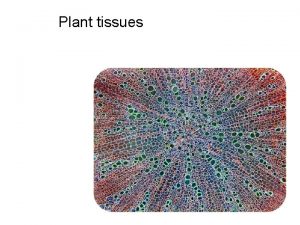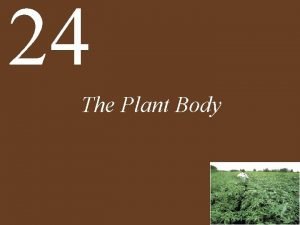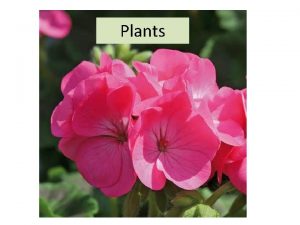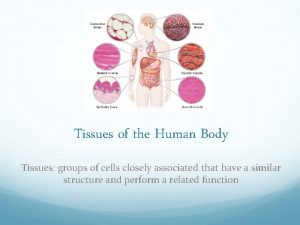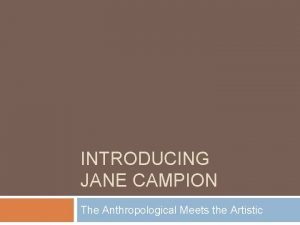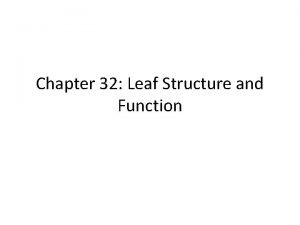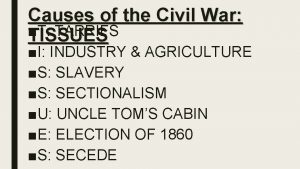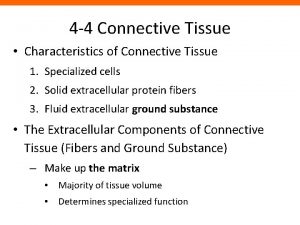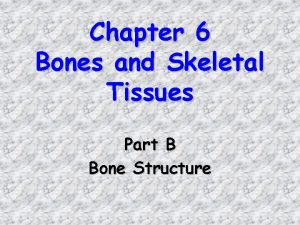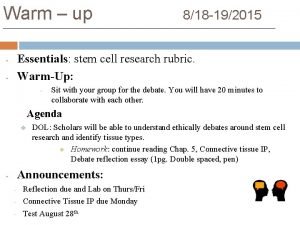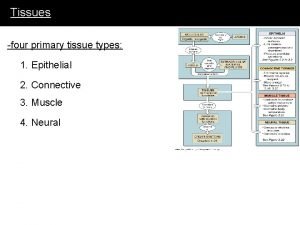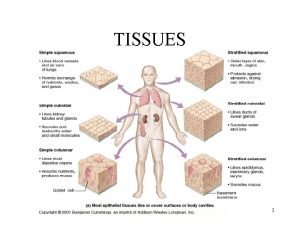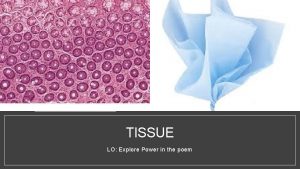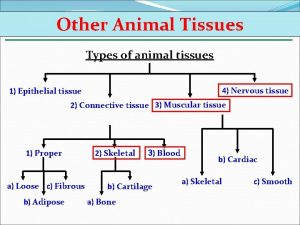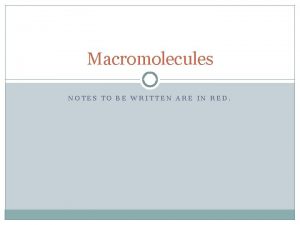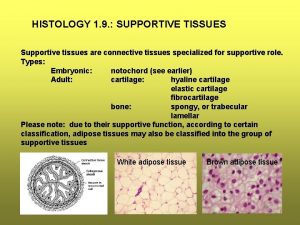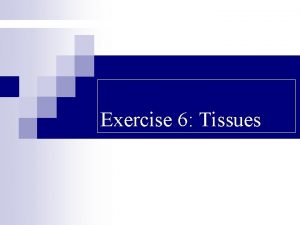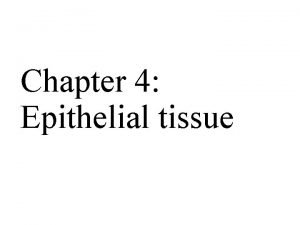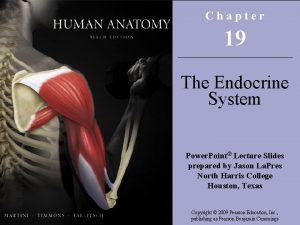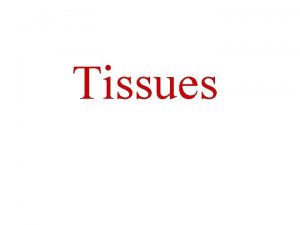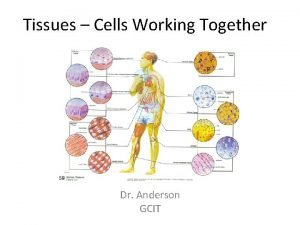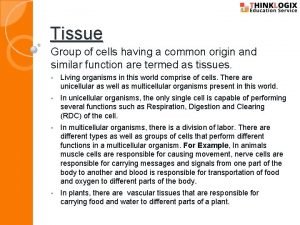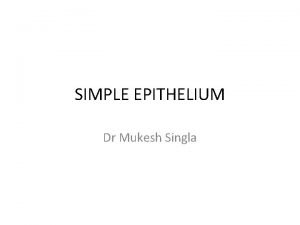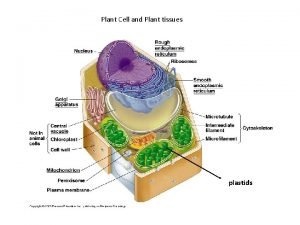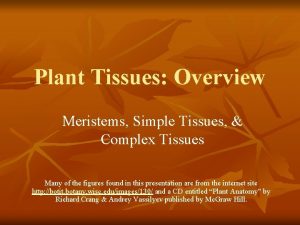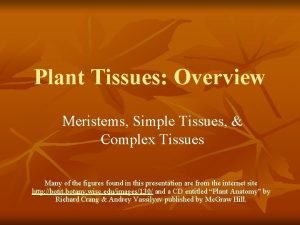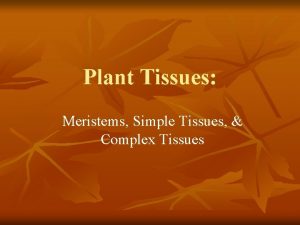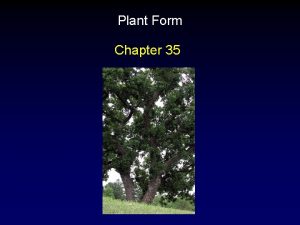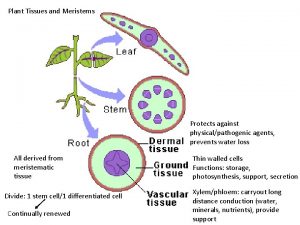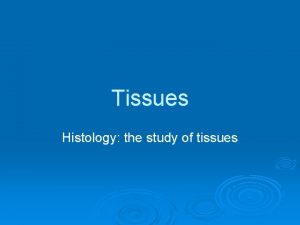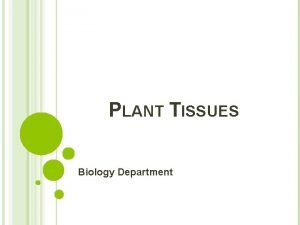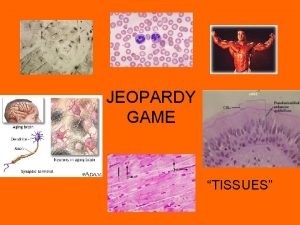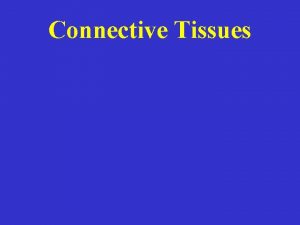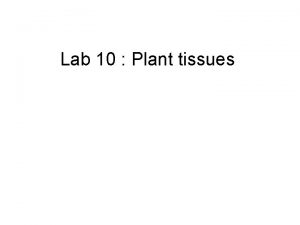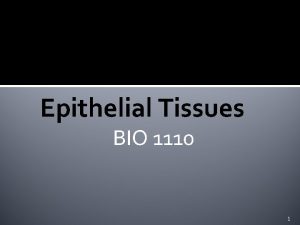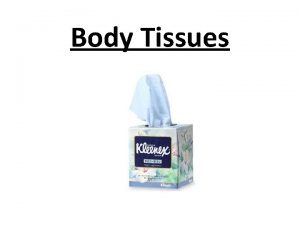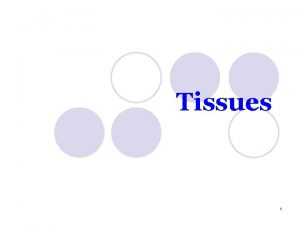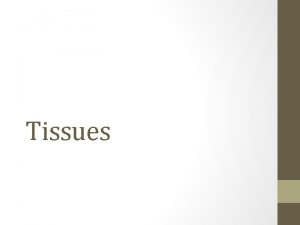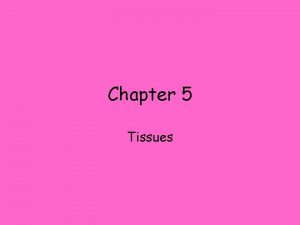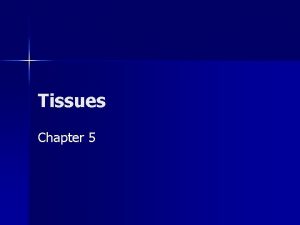2 Systems 3 Tissues 2 Meristems Photosynthesis Growth



















































- Slides: 51

¢ 2 Systems ¢ 3 Tissues ¢ 2 Meristems ¢Photosynthesis ¢Growth ¢Reproduction Plant Biology

Plant Body Systems Two types of systems: ¢ Root System ¢ Shoot System: stem, leaf, flower Plant organs: ¢ root, stem, leaf, flower ¢ referred to as plant parts

Root System Function ¢ Anchorage l l l ¢ Absorption l l ¢ Keeps plant in the soil Prevents soil erosion Holds stem in place water dissolved minerals Storage l l Starch Other nutrients

Types of Roots http: //www. bio. miami. edu/dana/pix/taproot_fibrousroot. jpg http: //kentsimmons. uwinnipeg. ca/2153/rootsystems 1. jpg http: //tchefty. wikispaces. com/file/view/rootsystems 1. jpg/260637884/rootsystems 1. jpg

Taproot Large long primary root ¢ Penetrate deep into the ground ¢ Small thin roots grow laterally off main root ¢ Strong anchoring system ¢ Examples: evergreen trees ¢

Taproot Specialized to store water, food, nutrients ¢ Better chance at drought survival ¢ Examples: carrot, beet, turnip, radish ¢ http: //www. ontarioweeds. com/media/jpg/tropr_root. jpg

Fibrous Root Many small roots that branch ¢ Increases surface area ¢ Better absorption of water and minerals ¢ Less structural support ¢ Examples: peas, beans, lettuce ¢

Root Hairs Small fibrous objects that branch off roots ¢ Absorbs water and minerals ¢

Root Zones Zone of maturation: cells differentiate into different types of cells ¢ Zone of elongation: allows the root to get deeper within the soil ¢ Meristematic region: rapid mitosis of undifferentiated meristematic cells ¢ Root cap: protects the meristematic region ¢

Shoot System Stem ¢ Leaf ¢ Flower ¢

Stem Raises and supports branches, leaves and flowers ¢ Transport of water and nutrients ¢ In trees the main stem is the tree trunk ¢ http: //www. pxleyes. com/images/contests/bw%20 tree%20 trunks/fullsize/bw%20 tree%20 trunks_4 b 6283790291 c. jpg

Stem ¢ Young green stems can perform photosynthesis because they have chloroplast in their epidermal cells

Some are specialized for food storage ¢ Examples: sugar cane, potatoes Stem ¢ http: //upload. wikimedia. org/wikipedia/commons/9/96/Sugar_Cane. jpg

Leaf Main function: Photosynthesis ¢ Parts of the Leaf: ¢ Cuticle l Epidermis l Guard Cells & Stoma l Palisade cells l Spongy Layer l Vascular Tissue l

Epidermis Outer layer of cells ¢ Leaf epidermis produces cuticle ¢ http: //www. goldiesroom. org/Multimedia/Bio_Images/05%20 Nutrition/15 a%20 Cross%20 Section%20 of%20 a%20 Leaf. jpg

Cuticle Waxy substance that coats the exterior ¢ Water proofing ¢ Protect interior tissues ¢ Blocks passage of gases ¢ http: //www. goldiesroom. org/Multimedia/Bio_Images/05%20 Nutrition/15 a%20 Cross%20 Section%20 of%20 a%20 Leaf. jpg

Guard Cells & Stoma ¢ ¢ ¢ Stoma (Greek for “mouth”) Pore-like openings in the plant’s epidermis Opening size controlled by two guard cells permits gas exchange between the leaf’s interior and external environment. larger opening, faster gas exchange

Guard Cells & Stoma

Spongy Layer Where water is stored ¢ Where the vascular tissues reside ¢

Palisade Cells Contains many chloroplast for photosynthesis ¢ Cells stand tall and upright ¢ Top end exposed to light l Bottom end exposed to the gases in the spongy layer l

Chloroplast Structure ¢ ¢ ¢ Thylakoids are flat disc-like structures where chlorophyll is embedded Grana are thylakoids arranged in a stack Chlorophyll is a pigment that captures light energy

Chloroplast Function Site for starch (a type of sugar) storage ¢ Site for photosynthesis ¢ Reaction involves trapping light energy to create food in the form of sugars ¢ Starting substances are carbon dioxide and water ¢ CO 2 + H 2 O + energy O 2 + glucose

Leaf Cross Section ¢ Scanning electron microscope image of a leaf from a Black Walnut tree. (Dartmouth Electron Microscope Facility/Dartmouth College) http: //cache. boston. com/universal/site_graphics/blogs/bigpicture/micro_11_14/m 04_walnut_leaf. jpg

Modified Leaf: Cactus

Poinsettia Leaves

Flower Specialized structures developed for sexual reproduction known as pollination ¢ Can contain both male and female reproductive structures in the same flower ¢

Flower Parts Male reproductive organ: stamen ¢ Female reproductive organ: pistil ¢ http: //www. exploringnature. org/graphics/teaching_aids/flower_parts_color 72. jpg

Flower Parts Male gametes: pollen grains found on anther ¢ Female gametes: ovule housed in ovary ¢

Pollination Act of sexual reproduction in plants ¢ Pollen reach stigma, travel down the style into the ovary to fertilize the ovule ¢

Methods of Pollination: Wind Pollen grains blown by wind ¢ Plants are often small and drab but produce a large amount of pollen ¢ Example: grass ¢ http: //www. vcbio. science. ru. nl/images/pollen-grass-stigma. jpg

Methods of Pollination: Animals ¢ Pollinators: Animals: birds, bats, and on fur of land animals l Insects: bees l ¢ Plants attract pollinators with: Large, colourful fragrant flowers l nectar l http: //4. bp. blogspot. com/_Xla 0 E 3 fw. Lto/S 4 CL_Nst. Zu. I/AAAABP 4/Pgo. Wyz-Mk 2 w/s 400/4342259001_e 10572466 d_b. jpg

Methods of Pollination: Animals ¢ Example: Dandelion plant attracting bees http: //guelph. ca/uploads/Healthy%20 Landscapes/Pollination_Bee_Dandelion_Zoom. jpg

After Pollination Zygote (fertilized egg) becomes the seed ¢ Ovary becomes the fruit ¢

After Pollination Zygote (fertilized egg) becomes the seed ¢ Ovary becomes the fruit ¢ http: //www. biosci. ohio-state. edu/~plantbio/osu_pcmb/pcmb_lab_resources/images/pcmb 101/flwrs_sds_frts/where_fruit. jpg

After Pollination http: //greatneck. k 12. ny. us/gnps/shs/dept/science/krauz/bio_h/images/38_09 Fruit. Development_L. jpg

Plant Tissue Dermal Tissue ¢ Vascular Tissue ¢ Ground Tissue ¢

Dermal Tissue Outermost layer of a plant ¢ Epidermis: thin layer of cells that covers the surface of leaf, stem and root ¢ Periderm tissue: bark on stem and large roots of woody plants (replaces the epidermis) ¢

Dermal Tissue Some dermal tissues have unique functions ¢ Root cells: root hairs (long extensions) ¢ Leaf cells: produce cuticle ¢

Vascular Tissue Plant circulatory system ¢ Vessels that connect roots to leaves ¢ Transports water, dissolved minerals, and sugars throughout plant, providing cells with materials to carry out life functions ¢ Two types: ¢ Xylem l Phloem l

Vascular Tissue: Xylem ¢ ¢ made up of long hollow tubes formed by non-living cell walls (left over from plant cells that have died) transports water and dissolved minerals upwards from roots

Vascular Tissue: Phloem Made up of elongated cells that are living ¢ Transports: ¢ solutions of sugars (food) l Dissolved nutrients l Hormones l ¢ Bi-directional movement of materials downward to roots l upward to leaves l

Vascular Bundle

Plant Sugars ¢ ¢ ¢ Starch is NOT soluble in water Starch can be broken down into sucrose Sucrose IS soluble in water Sucrose is transported through the phloem to the plant parts that require it Sucrose can be broken down into glucose Glucose is used in cellular respiration to make cellular energy Starch sucrose glucose

Spring ¢ ¢ Trees need energy to grow leaves Energy comes from cellular respiration of glucose: Glucose + oxygen carbon dioxide + water + energy ¢ Glucose can be obtained by: l l Photosynthesis - but spring trees don’t have any leaves to do photosynthesis Converting it from starch

Spring ¢ Starch l l l ¢ Sucrose l l l ¢ Stored in the roots Insoluble in water so it cannot be transported through phloem Convert to sucrose Soluble in water Transport from root to tree bud through phloem Convert to glucose in tree bud Glucose l l Use in cellular respiration Converted to cellular energy needed to grow leaves

Tree Sap Starch Sucrose Glucose Roots Stem Leaves Storage Transport Photosynthesis

Plant Sugars Sugar Solubility Location Function in water Starch No Sucrose Yes Glucose Yes Root Storage Stem Transport Leaf Cellular respiration

Summer Once leaves have grown, they can perform photosynthesis to produce their own glucose ¢ Glucose is converted to sucrose and transported through the phloem to the roots ¢ Sucrose is converted to starch in the roots for storage ¢

Sugar Movement through Phloem Glucose (leaves) Spring Summer and Fall Sucrose (stem) Summer and Fall Spring Starch (roots) Winter storage http: //www. nuscentscandle. com/blog/wp-content/uploads/tree-sap. jpg

Cells in the Root ¢ ¢ Cells in the root have no chloroplasts and are not exposed to sunlight so they can not undergo photosynthesis to make their own food Root cells must perform cellular respiration to obtain cellular energy Glucose + oxygen carbon dioxide + water + energy ¢ ¢ Glucose comes from the starch stored in the root Oxygen is absorbed through the soil

Ground Tissue Filler tissue in between the dermal and vascular tissue ¢ Variety of processes depending on where it is in the plant ¢ In leaf: palisade and spongy mesophyll cells ¢
 Body tissues chapter 3 cells and tissues
Body tissues chapter 3 cells and tissues The four major categories of tissues are
The four major categories of tissues are Body tissues chapter 3 cells and tissues
Body tissues chapter 3 cells and tissues Eisonophil
Eisonophil Stained cheek cell
Stained cheek cell Procambium
Procambium What are the three primary meristems
What are the three primary meristems Root
Root Meristem
Meristem Apical meristems
Apical meristems Where are loins on a human
Where are loins on a human Absolute growth rate and relative growth rate
Absolute growth rate and relative growth rate Pith
Pith Growthchain
Growthchain Primary growth and secondary growth in plants
Primary growth and secondary growth in plants Primary growth and secondary growth in plants
Primary growth and secondary growth in plants Geometric vs exponential growth
Geometric vs exponential growth Neoclassical growth theory vs. endogenous growth theory
Neoclassical growth theory vs. endogenous growth theory Organic growth vs inorganic growth
Organic growth vs inorganic growth Professional growth systems
Professional growth systems Specialised connective tissues
Specialised connective tissues Http://www.biologycorner.com/anatomy/histology/
Http://www.biologycorner.com/anatomy/histology/ 3 tissues of a plant
3 tissues of a plant Ground tissue
Ground tissue Jane campion tissues
Jane campion tissues Mesophyll function
Mesophyll function Tissues causes of civil war
Tissues causes of civil war Muscle tissue where is it found
Muscle tissue where is it found Characteristic of connective tissue
Characteristic of connective tissue Tissues are groups of similar cells working together to
Tissues are groups of similar cells working together to Genetic effects on gene expression across human tissues
Genetic effects on gene expression across human tissues Functions of blood connective tissue
Functions of blood connective tissue Chapter 6 bones and skeletal tissues
Chapter 6 bones and skeletal tissues Types of tissues
Types of tissues What are the four primary tissue types
What are the four primary tissue types Tissues are groups of similar cells working together to
Tissues are groups of similar cells working together to Connective tissue poem
Connective tissue poem Types of tissues
Types of tissues What macromolecule is a prominent part of animal tissues
What macromolecule is a prominent part of animal tissues Supportive tissues
Supportive tissues What is this tissue
What is this tissue Identify
Identify Tissue type
Tissue type Chapter 3 cells and tissues
Chapter 3 cells and tissues Chapter 3 cells and tissues figure 3-7
Chapter 3 cells and tissues figure 3-7 Endocrine tissues
Endocrine tissues Four major tissues
Four major tissues Tissues working together
Tissues working together Meristematic tissues in plants are
Meristematic tissues in plants are Tissues in the circulatory system
Tissues in the circulatory system Simple columnar epithelium tissue function
Simple columnar epithelium tissue function Plastids
Plastids





